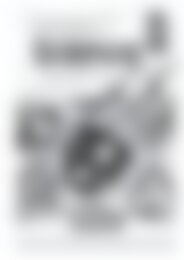RIC-30008 Eton Mess - Read discuss and understand a recipe
You also want an ePaper? Increase the reach of your titles
YUMPU automatically turns print PDFs into web optimized ePapers that Google loves.
©R.I.C. Publications<br />
Low Resolution Images<br />
Display Copy
<strong>Eton</strong> <strong>Mess</strong><br />
Curriculum links<br />
J<br />
• • • • • • • • • • • • • • • • • • • • • • • • • • •<br />
Teacher information<br />
Activity Content description Elaboration<br />
Text • <strong>Read</strong> decodable <strong>and</strong> predictable texts using developing phrasing, fluency, contextual, • <strong>Read</strong>s <strong>and</strong> <strong>discuss</strong>es a <strong>recipe</strong><br />
semantic, grammatical <strong>and</strong> phonic knowledge <strong>and</strong> emerging text processing strategies, for • Follows instructions in a procedure<br />
example prediction, monitoring meaning <strong>and</strong> re-reading (ACELY1659J O<br />
• Respond to texts drawn from a range of cultures <strong>and</strong> experiences (ACELY1655) 0<br />
'-<br />
Comprehension • Use comprehension strategies to build literal <strong>and</strong> inferred meaning about key events, • Underst<strong>and</strong>s the steps in a <strong>recipe</strong><br />
ideas <strong>and</strong> information in texts that they listen to, view <strong>and</strong> read by drawing on growing<br />
knowledge of context, text structures <strong>and</strong> language features (ACELY1660) O<br />
Word knowledge<br />
Additional teacher<br />
information<br />
• Recognise <strong>and</strong> know how to use simple grammatical morphemes to create word families<br />
(ACELA1455) 0<br />
• Use visual memory to read <strong>and</strong> write high-frequency words (ACELA1821) 0<br />
• Explore differences in words that represent people, places <strong>and</strong> things (nouns, including<br />
pronouns), happenings <strong>and</strong> states (verbs), qualities (adjectives) <strong>and</strong> details such as when,<br />
where <strong>and</strong> how (adverbs) (ACELA1452J O<br />
Definition of terms<br />
Recipe<br />
A <strong>recipe</strong> is a procedure or set of instructions for preparing a<br />
particular dish, including a list of the ingredients required. A<br />
procedure tells how to make or do something. It uses clear,<br />
concise language <strong>and</strong> comm<strong>and</strong> verbs.<br />
Links to other curriculum areas<br />
• Health <strong>and</strong> Physical Education<br />
- Recognise situations <strong>and</strong> opportunities to promote<br />
health, safety <strong>and</strong> wellbeing (ACPPS01BJ G<br />
• Identifies high-frequency sight words<br />
• Creates plurals of words ending with '-s' <strong>and</strong><br />
'-es'<br />
• Identifies adjectives in a text<br />
• identifies double letters in words<br />
Terminology for students<br />
<strong>recipe</strong><br />
instruction/step<br />
word<br />
bracket<br />
adjective<br />
double letters<br />
Suggested reading<br />
• Once upon a time in the kitchen: Recipes <strong>and</strong> tales from<br />
classic children s stories (Myths, legends, fairy <strong>and</strong> folktales)<br />
by Carol Odell (stories for listening)<br />
• Fancy Nancy: Tea parties by Jane O'Connor<br />
• Tyler makes a birthday cake! (Tyler <strong>and</strong> Tofu) by Tyler<br />
Florence<br />
©R.I.C. Publications<br />
Low Resolution Images<br />
Display Copy<br />
• Tiny pie by Mark Bailey<br />
1 • · • • • • • • Developing comprehension skills <strong>and</strong> word knowledge (Year 1) • • • • • • R.I.C. Publications ® · • • • • www.ricpublications.com.au
Teaching notes<br />
J<br />
Text<br />
Comprehension<br />
Teacher information<br />
Teacher information<br />
• This English dessert is traditionally served at the annual cricket<br />
game between <strong>Eton</strong> College <strong>and</strong> Harrow School in Engl<strong>and</strong>.<br />
• The three main ingredients are strawberries, cream <strong>and</strong><br />
meringue. Some people believe the dessert was given its name<br />
because a meringue dessert was accidentally crushed by a dog<br />
while in transit to a picnic at <strong>Eton</strong>. It was served as a 'messy'<br />
dessert of crushed meringues, cream <strong>and</strong> strawberries.<br />
Introduction<br />
• Discuss desserts with the students. Ask them if they know the<br />
names of some of the more popular desserts. Ask the students<br />
when desserts are served. Ask them what ingredients desserts<br />
usually have. Explain that they will read a <strong>recipe</strong> that tells how<br />
to make a dessert. Ask them where they might find a <strong>recipe</strong>.<br />
Discuss the name of the dessert. Does the word 'mess' sound<br />
good or bad in a <strong>recipe</strong>?<br />
Development<br />
• <strong>Read</strong> <strong>and</strong> <strong>discuss</strong> the text with the students. Assist them with<br />
any unfamiliar words such as units of measure, or the list of<br />
ingredients. One tricky word in this text is 'meringue'. Explain<br />
that this is a French word that is now used in English. Point<br />
out the tricky ending. Explain what the 'Steps' mean. Question<br />
the students to gauge their underst<strong>and</strong>ing of what they have<br />
listened to or read.<br />
• While reading, observe <strong>and</strong> listen to how students use phonic<br />
skills <strong>and</strong> knowledge to decode words. Assist them to decode<br />
more difficult words.<br />
• If reading the <strong>recipe</strong> together as a class, correct inaccurate<br />
reading.<br />
• Teachers may need to pronounce some words <strong>and</strong> exaggerate<br />
the sound being identified to help students answer any<br />
questions relating to phonic skills <strong>and</strong> knowledge.<br />
• Ask the students to work together to explain how to make <strong>Eton</strong><br />
<strong>Mess</strong>.<br />
Differentiated individual/paired/group work<br />
• Ask the students to work in pairs to list the ingredients <strong>and</strong> to<br />
illustrate each step of the <strong>recipe</strong>.<br />
• Allow more capable readers to research their favourite dessert<br />
<strong>and</strong> make a list of the ingredients needed for it.<br />
• Teachers could work with a small group of less capable readers<br />
to look at all the adjectives in the <strong>recipe</strong> (this is the focus of<br />
the word knowledge activities, so practice at this point would<br />
ensure higher confidence to answer these questions in a later<br />
lesson).<br />
Review<br />
• Summarise the main features of the <strong>recipe</strong>.<br />
• The questions on page 52 require the students to be confident<br />
about the general concept of a <strong>recipe</strong> as well as underst<strong>and</strong>ing<br />
a specific <strong>recipe</strong> for <strong>Eton</strong> <strong>Mess</strong>.<br />
Introduction<br />
• Students take turns to retell how to make <strong>Eton</strong> <strong>Mess</strong>. They must<br />
list all the ingredients first, then outline the steps to make it.<br />
Development<br />
• Discuss the comprehension activities on page 52, then allow<br />
the students to complete the page independently.<br />
• Question 8 will have different answers, which can lead to an<br />
interesting <strong>discuss</strong>ion.<br />
Differentiated individual/paired/group work<br />
• Have students work in pairs to write a <strong>recipe</strong> for their favourite<br />
s<strong>and</strong>wich. Encourage them to use the <strong>Eton</strong> <strong>Mess</strong> <strong>recipe</strong> as a<br />
template (stating how many it will serve, the list of ingredients<br />
<strong>and</strong> the steps).<br />
• With adult support, groups work to create this dessert.<br />
Encourage them to read out each step clearly <strong>and</strong> follow the<br />
instructions. Discuss hygiene issues <strong>and</strong> safe food preparation.<br />
(Alternatively, this could be completed as a whole-class activity<br />
<strong>and</strong> groups asked to carry out different steps in the <strong>recipe</strong>.)<br />
Review<br />
• The students can read out their <strong>recipe</strong>s for their favourite<br />
s<strong>and</strong>wich.<br />
©R.I.C. Publications<br />
Low Resolution Images<br />
Display Copy<br />
R.I.C. Publications ® • • • • • • • www.ricpublications.com.au • • • • • • • Developing comprehension skills <strong>and</strong> word knowledge (Year 1) • • • • • • 2
Teaching notes<br />
(continued)<br />
Answers<br />
J<br />
Teacher information<br />
Word knowledge<br />
• The activities on page 53 focus on singular <strong>and</strong> plural nouns,<br />
verbs <strong>and</strong> double letters in words.<br />
Introduction<br />
• Re-read the text, explaining to the students that the focus will<br />
be on words. While reading, ask them to underline all the plural<br />
words <strong>and</strong> objectives.<br />
Development<br />
• After reading, ask the students to share the plural words they<br />
found in the <strong>recipe</strong>. Write a list on the board. Make up a table<br />
with columns to list words ending in 's', words ending in 'es'<br />
<strong>and</strong> words ending with 'y'. Ask students to give the rules for<br />
making the plural: most words add '-s', but some words add<br />
'-es' (<strong>discuss</strong> if they can see a rule for adding '-es'). One of the<br />
columns will have plurals made from words ending in 'y' (berry,<br />
berries). Even though this is not the focus of this lesson, draw<br />
students' attention to this feature.<br />
• Revise the term adjectives. Use some of the words in the text,<br />
'yummy' <strong>and</strong> 'mixed', to demonstrate that adjectives describe<br />
nouns. Give examples <strong>and</strong> ask for others from the students.<br />
• Discuss the word reading activities on page 53, then allow<br />
students to complete the page independently.<br />
Differentiated individual/paired/group work<br />
• Ask students to draw pictures of the yoghurt, mixer <strong>and</strong> a<br />
tablespoon then write an adjective to describe each.<br />
• Ask more capable readers to see how many of the steps they<br />
can write in the correct order.<br />
Review<br />
• As a class, ask students to think of other nouns <strong>and</strong> an<br />
accompanying adjective (not mentioned in the <strong>recipe</strong>).<br />
Comprehension<br />
1. Answers will vary.<br />
2. (a) blue/purple (b) black/dark purple<br />
3. All should be ticked.<br />
4. grams, tablespoon, teaspoon, ml<br />
5. mixed berries, icing sugar, double cream, vanilla, Greek<br />
yoghurt, meringue nests<br />
6. cream<br />
7. Answers may include lemon meringue pie, baked Alaska,<br />
pavlova etc.<br />
8. Answers will vary.<br />
Word knowledge<br />
1. (a) one (b) more than one<br />
2. (a) dishes (b) brushes (c) boxes (d) buses<br />
3. (a) foxes (b) classes (c) mosses<br />
(d) bushes<br />
(e) lashes<br />
4. (a) yummy (b) mixed (c) small<br />
(d) large (e) soft (f) Greek<br />
5. Teacher check<br />
©R.I.C. Publications<br />
Low Resolution Images<br />
Display Copy<br />
3 • · • • • • • • Developing comprehension skills <strong>and</strong> word knowledge (Year 1) • • • • • • R.I.C. Publications ® · • • • • www.ricpublications.com.au
<strong>Eton</strong> <strong>Mess</strong> - 1<br />
<strong>Read</strong> the <strong>recipe</strong>.<br />
Follow the instructions to make a yummy<br />
dessert called <strong>Eton</strong> <strong>Mess</strong>.<br />
Serves four people<br />
You will need:<br />
• 260 grams mixed berries<br />
(blueberries, blackberries, strawberries or raspberries)<br />
• 1 tablespoon icing sugar plus 1 teaspoon extra<br />
• 125 ml double cream<br />
• quarter teaspoon vanilla<br />
• 1 x 200-gram pot Greek yoghurt<br />
• 2 meringue nests, broken into pieces<br />
• mixer <strong>and</strong> bowl<br />
Steps:<br />
• spoon<br />
• large bowl<br />
• small bowls or glasses<br />
1. Put berries into large bowl. Add tablespoon icing sugar <strong>and</strong> mix<br />
lightly.<br />
2. Put cream, 1 teaspoon icing sugar <strong>and</strong> vanilla in mixer bowl <strong>and</strong><br />
whip until soft peaks form.<br />
3. Fold yoghurt into cream, then add berries <strong>and</strong> meringue.<br />
4. Spoon into small bowls or glasses. Chill for a few minutes.<br />
5. Eat <strong>and</strong> enjoy!<br />
©R.I.C. Publications<br />
Low Resolution Images<br />
Display Copy<br />
How did you do?<br />
Do you think you could make this? Do you think it would taste yummy?<br />
My learning log When I read this <strong>recipe</strong>, I could read: 0 all of it. 0 most of it. 0 parts of it.<br />
R.I.C. Publications ® • • • • • • • www.ricpublications.com.au • • • • • • • Developing comprehension skills <strong>and</strong> word knowledge (Year 1) • • • • • • 4
<strong>Eton</strong> <strong>Mess</strong> - 2<br />
Comprehension<br />
1. Tick the berries you have eaten.<br />
D D<br />
blueberries<br />
blackberries<br />
D D<br />
strawberries raspberries<br />
2. What colour, do you think, are:<br />
(a) blueberries?<br />
(b) blackberries?<br />
3. Tick the things that are part of a <strong>recipe</strong>.<br />
(a) a list of things you need<br />
(c) the name of the thing you are making<br />
4. Write four units of measure.<br />
D<br />
D<br />
5. Write six ingredients you need to make <strong>Eton</strong> <strong>Mess</strong>.<br />
6. Which word means 'fatty liquid on the top of milk'?<br />
7. What other dessert is made with meringue?<br />
©R.I.C. Publications<br />
Low Resolution Images<br />
Display Copy<br />
(b)<br />
steps<br />
D<br />
8. Do you think you would enjoy eating this dessert?l Yes J 8<br />
Why? _____________________ _<br />
My learning log<br />
While doing these activities:<br />
I found a __ easy. I I found a __ tricky. I I found a __ fun.<br />
5 • • • • • • • • Developing comprehension skills <strong>and</strong> word knowledge (Year 1) • • • • • • R.I.C. Publications ® · • • • • www.ricpublications.com.au
<strong>Eton</strong> <strong>Mess</strong> - 3<br />
Word knowledge<br />
1 . How many? One or more than one?<br />
(a) glass<br />
(b) glasses<br />
8 l more than one J<br />
8 l more than one J<br />
2. Add '-es' to make the words say more than one.<br />
(a) dish _______ (b) brush _______<br />
(c) box (d) bus<br />
3. Change each word in brackets to make it correct.<br />
(a) Three (fox) ________ came near the henhouse.<br />
(b) The two Year 1 (class) ________ went on a trip.<br />
(c) The forest was full of (moss)<br />
(d) The gardener planted (bush) ________ all around the<br />
garden.<br />
(e)<br />
My (eyelash) ________ keep my eyes safe from dust.<br />
4. Adjectives describe nouns-people, places or things. Adjectives can<br />
describe size, shape, colour, number or where things come from.<br />
Write one adjective from the text for each noun.<br />
(a)<br />
______ dessert<br />
©R.I.C. Publications<br />
Low Resolution Images<br />
Display Copy<br />
(b) _________ berries<br />
(c)<br />
(e)<br />
______ bowls<br />
______ peaks<br />
(d) _________ bowl<br />
(f) _________ yoghurt<br />
5. Draw a line under the double letters.<br />
mess vanilla berries glasses<br />
chill<br />
small<br />
I can make the plural of 'glass', 'bowl' <strong>and</strong> 'box'.<br />
My learning log Colour: I know what an adjective is.<br />
I can find adjectives in a text.<br />
R.I.C. Publications ® • • • • • • • www.ricpublications.com.au • • • • • • • Developing comprehension skills <strong>and</strong> word knowledge (Year 1) • • • • • • 6<br />
978-1-925431-80-3


















